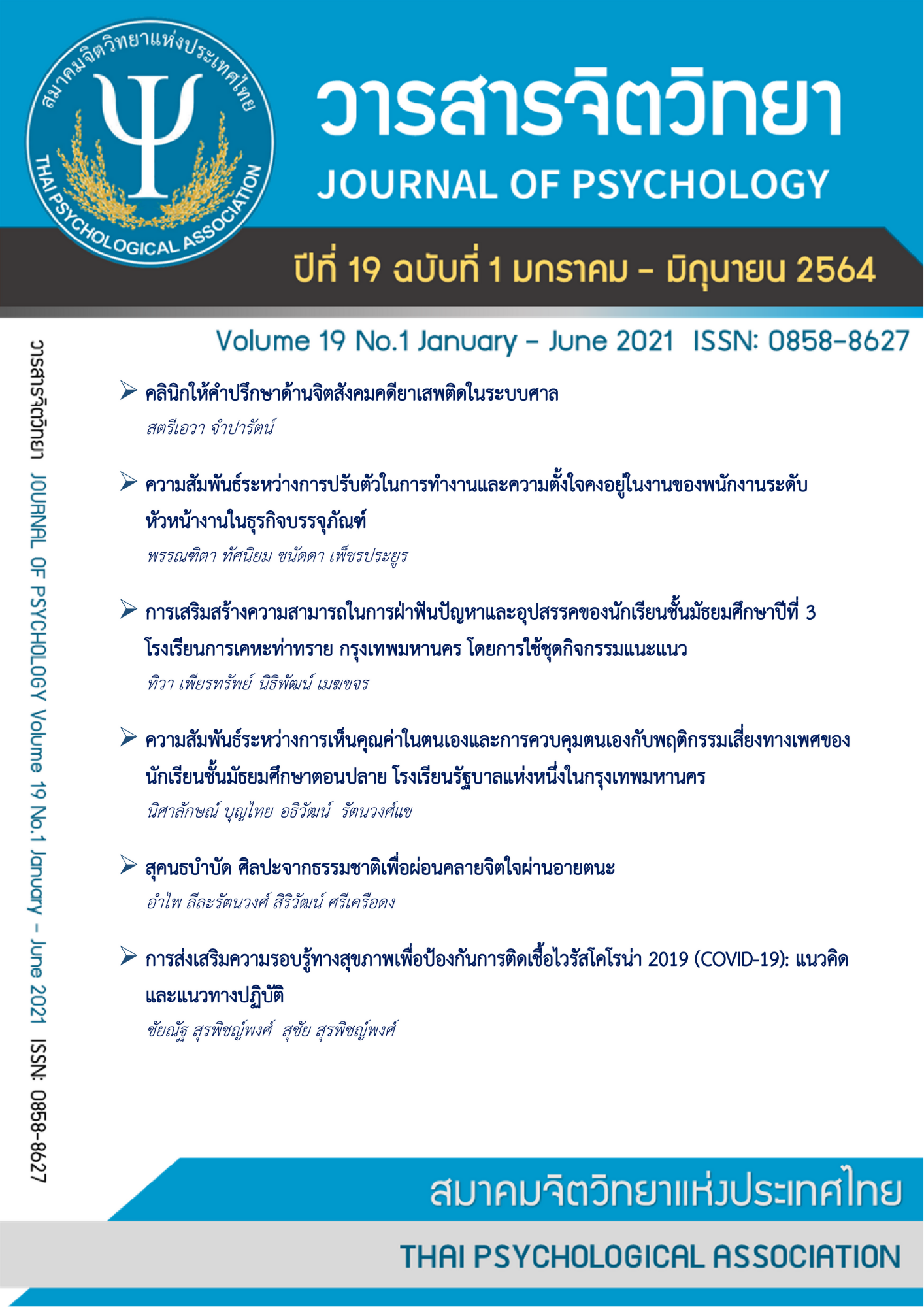The Relationships among Self-Esteem, Self-Control, and Sexual Risk Behaviors of Upper Secondary School Students in a Public School, Bangkok
Keywords:
Self-Esteem, Self-Control, Sexual Risk BehaviorsAbstract
The objectives of this study were 1) to study the level of sexual risk behavior of students 2) to compare sexual risk behaviors of students classified by gender and monthly income 3) to study the relationship between self-esteem and sexual risk behaviors of students and 4) to study the relationship between self-control and sexual risk behaviors of students. The sample of this study was 328 students in upper secondary level of a public school in Bangkok. A research instrument was a questionnaire, containing four parts: personal factors, sexual risk behavior, self-esteem, and self-control. Data were analyzed using frequency, percentage, mean, standard deviation, t-test for independent sample and Pearson's product moment correlation coefficient. Computer software was also used to process and analyze data.
The results of this study indicated as follows: (1) Overall sexual risk behavior of the respondents was at a low level with a mean of 1.93 of full score of 5.00 (2) The respondents with different gender had different sexual risk behavior with a statistical significance level of .001. Male respondents had higher sexual risk behavior than counterparts (3) The respondents with different monthly income had different sexual risk behavior with a statistical significance level of .01. The respondents with monthly income of 3,000 baht or above had higher sexual risk behavior than those earned below 3,000-baht (4) Self-esteem was negatively related with sexual risk behavior with a statistical significance level of .001, with the correlation coefficient of -.247 and (5) Self-control was negatively related with sexual risk behavior with a statistical significance level of .001, with the correlation coefficient of -.634
References
เจษฎา อังกาบสี. (2558). เอกสารประกอบการเรียนการสอนรายวิชา จว.102 จิตวิทยาพัฒนาการ. คณะจิตวิทยา
มหาวิทยาลัยเกษมบัณฑิต.
ชูศรี วงศ์รัตนะ. (2553). เทคนิคการใช้สถิติเพื่อการวิจัย (พิมพ์ครั้งที่12). นนทบุรี: ไทยเนรมิตกิจ อินเตอร์โปร
เกรสซิฟ.
ณัฐธิดา ปัญจะโรทัย, สุปรียา ตันสกุล, มณีรัตน์ ธีระวิวัฒน์ และนิรัตน์ อิมามี. (2556). ปัจจัยที่มีความสัมพันธ์
กับพฤติกรรมเสี่ยงทางเพศของนักเรียนมัธยมศึกษาหญิงในจังหวัดนครนายก (วิทยานิพนธ์ สาขาสุข ศึกษา
และพฤติกรรมศาสตร์). มหาวิทยาลัยมหิดล.
ทิพย์สิริ กาญจนวาสี. (2557). ความตระหนักรู้เรื่องเพศ ความรู้เรื่องเพศและแนวทางป้องกันพฤติกรรมเสี่ยง
ทางเพศ. กรุงเทพ: สำนักพิมพ์แห่งจุฬาลงกรณ์มหาวิทยาลัย.
นันทวัช สิทธิรักษ์. (2558). จิตเวชศิริราช DSM-5 (พิมพ์ครั้งที่ 2). กรุงเทพ: ประยูรสาสน์การพิมพ์.
นพมาศ อุ้งพระ. (2546). ทฤษฎีบุคลิกภาพและการปรับตัว (พิมพ์ครั้งที่ 3). กรุงเทพ: สํานักพิมพ์มหาวิทยาลัย
ธรรมศาสตร์.
ประเทือง ภูมิภัทราคม. (2540). ปรับพฤติกรรม : ทฤษฏีและการประยุกต์. กรุงเทพ: ไอเอสพริ้นติ้งเอ้าส์.
พนอวดี จันทนา. (2547). พฤติกรรมเสี่ยงต่อการมีเพศสัมพันธ์ของนักเรียนมัธยมศึกษาตอนปลายในชุมชน
เกาะสมุย (วิทยานิพนธ์ สาขาวิชาจิตวิทยาชุมชน). มหาวิทยาลัยศิลปากร.
พนมพร ปิยะกุล ฉวีวรรณ บุญสุยา และอรนุช ภาชื่น. (2559). พฤติกรรมเสี่ยงต่อการมีเพศสัมพันธ์ของ
นักเรียนอาชีวศึกษาในจังหวัดสมุทรปราการ (วิทยานิพธ์ สาขาวิชาสาธารณสุขศาสตรมหาบัณฑิต).
มหาวิทยาลัยธรรมศาสตร์.
พรนภา หอมสินธุ์. (2558). แนวคิดและทฤษฏี สู่การปฎิบัติ : การป้องกันการสูบบุหรี่และดื่มเครื่องดื่ม แอลกอฮอล์
ในวัยรุ่น. ชลบุรี: ชลบุรีการพิมพ์.
ลัชนา ฉายศรี. (2553). ปัจจัยที่มีอิทธิพลต่อพฤติกรรมเสี่ยงทางเพศของนักเรียนมัธยมศึกษาตอน ปลายจังหวัด
ประจวบคีรีขันธ์ (ปริญญานิพนธ์ สาขาวิชาเอกอนามัยครอบครัว). มหาวิทยาลัยมหิดล
วิไลวรรณ ศรีสงคราม. (2549). จิตวิทยาทั่วไป Gennaral Phychology. กรุงเทพ: ทริปเพิ้ลเอ็ดดูเคชั่น.
สายัณห์ สวัสดิ์ศรี และทีมแพทย์ผู้เชี่ยวชาญเฉพาะทาง. (2549). คู่มือรู้จักรักแท้. กรุงเทพ: เรือนปัญญา.
สำนักงานคณะกรรมการพัฒนาเศรษฐกิจและสังคมแห่งชาติ. (2555). ภาวะสังคมไทย ไตรมาสสี่และภาพรวมปี
สืบค้นเมื่อ 29 มิถุนายม 2561, จากhttps://www.nesdc.go.th/ewt_w3c/ewt_dl_link.php?
filename=social&nid=10903
สุพัตรา พรหมเรนทร์. (2550). พฤติกรรมเสี่ยงทางเพศของนักเรียนมัธยมศึกษาตอนต้น โรงเรียนสาธิต
มหาวิทยาลัยศรีนครินทรวิโรฒ ปทุมวัน กรุงเทพมหานคร (ปริญญานิพนธ์ สาขาวิชาสุขศึกษา). มหาวิทยาลัย
ศรีนครินทรวิโรฒ.
สุวรรณา เรืองกาญจนเศรษฐ์. (2551). กลยุทธ์การสร้างเสริมสุขภาพวัยรุ่น. กรุงเทพ: โรงพิมพ์ชัยเจริญ.
สมบุญ ศิลป์รุ่งธรรม. (2553). ปัจจัยที่มีผลต่อพฤติกรรมเสี่ยงทางเพศของนิสิตปริญญาตรี สาขาพล ศึกษาและ
สุขศึกษา คณะศึกษาศาสตร์และพัฒนศาสตร์ มหาวิทยาลัยเกษตรศาสตร์ วิทยาเขต กำแพงแสน
(วิทยานิพนธ์ สาขาวิชาสาธารณสุขศาสตร์บริหารสาธารณสุข). มหาวิทยาลัยทักษิณ
อังคณา เพชรกาฬ. (2551). ปัจจัยที่มีความสัมพันธ์ต่อการมีเพศสัมพันธ์ของนักเรียนวัยรุ่นภาคใต้ ตอนบน
(วิทยานิพนธ์ สาขาวิชาเอกสุขศึกษาและพฤติกรรมศาสตร์). มหาวิทยาลัยมหิดล.
อรชร อัฐทวีลาภ. (2544). พฤติกรรมทางเพศของวัยรุ่นในจังหวัดภูเก็ต. สืบค้นเมื่อ 29 มิถุนายม 2561, จาก
Published
How to Cite
Issue
Section
License
Copyright (c) 2021 Thai Psychological Association

This work is licensed under a Creative Commons Attribution-NonCommercial-NoDerivatives 4.0 International License.
บทความที่ได้รับการตีพิมพ์เป็นลิขสิทธิ์ของสมาคมจิตวิทยาแห่งประเทศไทย
ข้อความที่ปรากฎในบทความแต่ละเรื่องในวารสารวิชาการเล่มนี้เป็นความคิดเห็นส่วนตัวของผู้เขียนแต่ละท่านไม่เกี่ยวข้องกับสมาคมจิตวิทยาแห่งประเทศไทย แต่อย่างใด ความรับผิดชอบองค์ประกอบทั้งหมดของบทความแต่ละเรื่องเป็นของผู้เขียนแต่ละท่าน หากมีความผิดพลาดใด ๆ ผู้เขียนแต่ละท่านจะรับผิดชอบบทความของตนเองแต่ผู้เดียว






